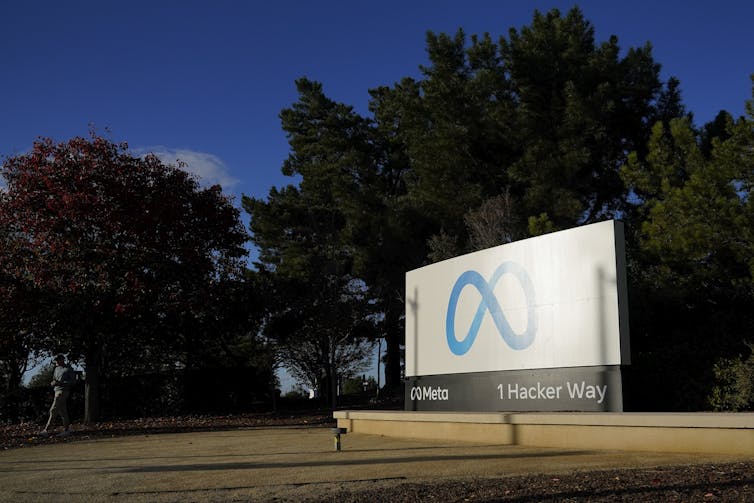Meta, the parent of Facebook, recently became the latest of the industry’s dominant players to lay off thousands of employees, particularly middle managers, in an effort to return to a flatter, more nimble organization – a structure more typical when a company is very young or very small.
Meta CEO Mark Zuckerberg joins Elon Musk and other business leaders in betting that eliminating layers of management will boost profits. But is flatter better? Will getting rid of managers improve organizational efficiency and the bottom line?
As someone who has studied and taught organization theory as well as leadership and organizational behavior for nearly a decade, I think it’s not that simple.
Resilient bureaucracies
Since the 1800s, management scholars have sought to understand how organizational structure influences productivity. Most early scholars focused on bureaucratic models that promised managerial authority, rational decision-making and efficiency, impartiality and fairness toward employees.
These centralized bureaucratic structures still reign supreme today. Most of us have likely worked in such organizations, with a boss at the top and clearly defined layers of management below. Rigid, written rules and policies dictate how work is done.
Research shows that some hierarchy correlates with commercial success – even in startups – because adding just one level of management helps prevent directionless exploration of ideas and damaging conflicts among staff. Bureaucracies, in their pure form, are viewed as the most efficient way to organize complex companies; they are reliable and predictable.
While adept at solving routine problems, such as coordinating work and executing plans, hierarchies do less well adapting to rapid changes, such as increased competition, shifting consumer tastes or new government regulations.
Bureaucratic hierarchies can stifle the development of employees and limit entrepreneurial initiative. They are slow and inept at tackling complex problems beyond the routine.
Moreover, they are thought to be very costly. Management scholars Gary Hamel and Michele Zanini estimated in 2016 that waste, rigidity and resistance to change in bureaucratic structures cost the U.S. economy US$3 trillion in lost output a year. That is the equivalent of about 17% of all goods and services produced by the U.S. economy at the time of the study.
Even with the mounting criticisms, bureaucratic structures have shown resilience over time. “The formal managerial hierarchy in modern organizations is as persistent as are calls for its replacement,” Harvard scholars Michael Lee and Amy Edmondson wrote in 2017.

Fascinatingly flat
Flat structures, on the other hand, aim to decentralize authority by reducing or eliminating hierarchy. The structure is harnessed to flexibility and agility rather than efficiency, which is why flat organizations adapt better to dynamic and changing environments.
Flat structures vary. Online retailer Zappos, for example, adopted one of the most extreme versions of the flat structure – known as holacracy – when it eliminated all managers in 2014. Computer game company Valve has a president but no formal managerial structure, leaving employees free to work on projects they choose.
Other companies, such as Gore Tex maker W. L. Gore & Associates and film-streaming service Netflix, have instituted structures that empower employees with wide-reaching autonomy but still allow for some degree of management.
In general, flat structures rely on constant communication, decentralized decision-making and the self-motivation of employees. As a result, flat structures are associated with innovation, creativity, speed, resilience and improved employee morale.
The promises of going flat are understandably enticing, but flat organizations are tricky to get right.
The list of companies succeeding with flat structures is noticeably short. Besides the companies mentioned above, the list typically includes social media marketing organization Buffer, online publisher Medium and tomato processing and packing company Morning Star Tomatoes.
Other organizations that attempted flatter structures have encountered conflicts between staff, ambiguity around job roles and the emergence of unofficial hierarchies – which undermines the whole point of going flat. They eventually reverted back to hierarchical structures.
“While people may lament the proliferation of red tape,” management scholars Pedro Monteiro and Paul Adler explain, “in the next breath, many complain that ‘there ought to be a rule.’”
Even Zappos, often cited as the case study for flat organizations, has slowly added back managers in recent years.
Right tool
In many ways, flat organizations require even stronger management than hierarchical ones.
When managers are removed, the span of control for those remaining increases. Corporate leaders must delegate – and track – tasks across greater numbers of employees and constantly communicate with workers.
Careful planning is needed to determine how work is organized, information shared, conflicts resolved and employees compensated, hired and reviewed. It is not surprising that as companies grow, the complexity of bigger organizations poses barriers to flat models.
In the end, organizational structure is a tool. History shows that business and economic conditions determine which type of structure works for an organization at any given time.
All organizations navigate the trade-off between stability and flexibility. While a hospital system facing extensive regulations and patient safety protocols may require a stable and consistent hierarchy, an online game developer in a competitive environment may need an organizational structure that’s more nimble so it can adapt to changes quickly.
Business and economic conditions are changing for Big Tech, as digital advertising declines, new competitors surface and emerging technologies demand risky investments. Meta’s corporate flattening is one response.
As Zuckerberg noted when explaining recent changes, “Our management theme for 2023 is the ‘Year of Efficiency,’ and we’re focused on becoming a stronger and more nimble organization.”
But context matters. So does planning. All the evidence I’ve seen indicates that embracing flatness by cutting middle management will not, by itself, do much to make a company more efficient.
Amber Stephenson, Associate Professor of Management and Director of Healthcare Management Programs, Clarkson University
This article is republished from The Conversation under a Creative Commons license. Read the original article.
![]()